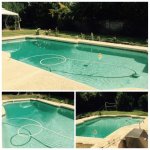I tested my pool water two times within 4 days just to make sure I am doing this correctly. Results were pretty much the same both times:
Chlorine: ZERO - not pink. Watery white.
Calcium Hardness: 2,875 ppm or 3,750 ppm depending on which blue is blue enough.
Total Alkalinity: 60 or 230, depending on which red is the proper red
CYA Test: The reading is > 100. I didn't have to pour much solution before the dot disappeared.
Check out the photos below to see the colors I'm referring to. I think I need to drain the pool and fill it with new water, right? Sounds like it might be time to add that lazy river I've been dreaming of...

Chlorine: ZERO - not pink. Watery white.
Calcium Hardness: 2,875 ppm or 3,750 ppm depending on which blue is blue enough.
Total Alkalinity: 60 or 230, depending on which red is the proper red
CYA Test: The reading is > 100. I didn't have to pour much solution before the dot disappeared.
Check out the photos below to see the colors I'm referring to. I think I need to drain the pool and fill it with new water, right? Sounds like it might be time to add that lazy river I've been dreaming of...


